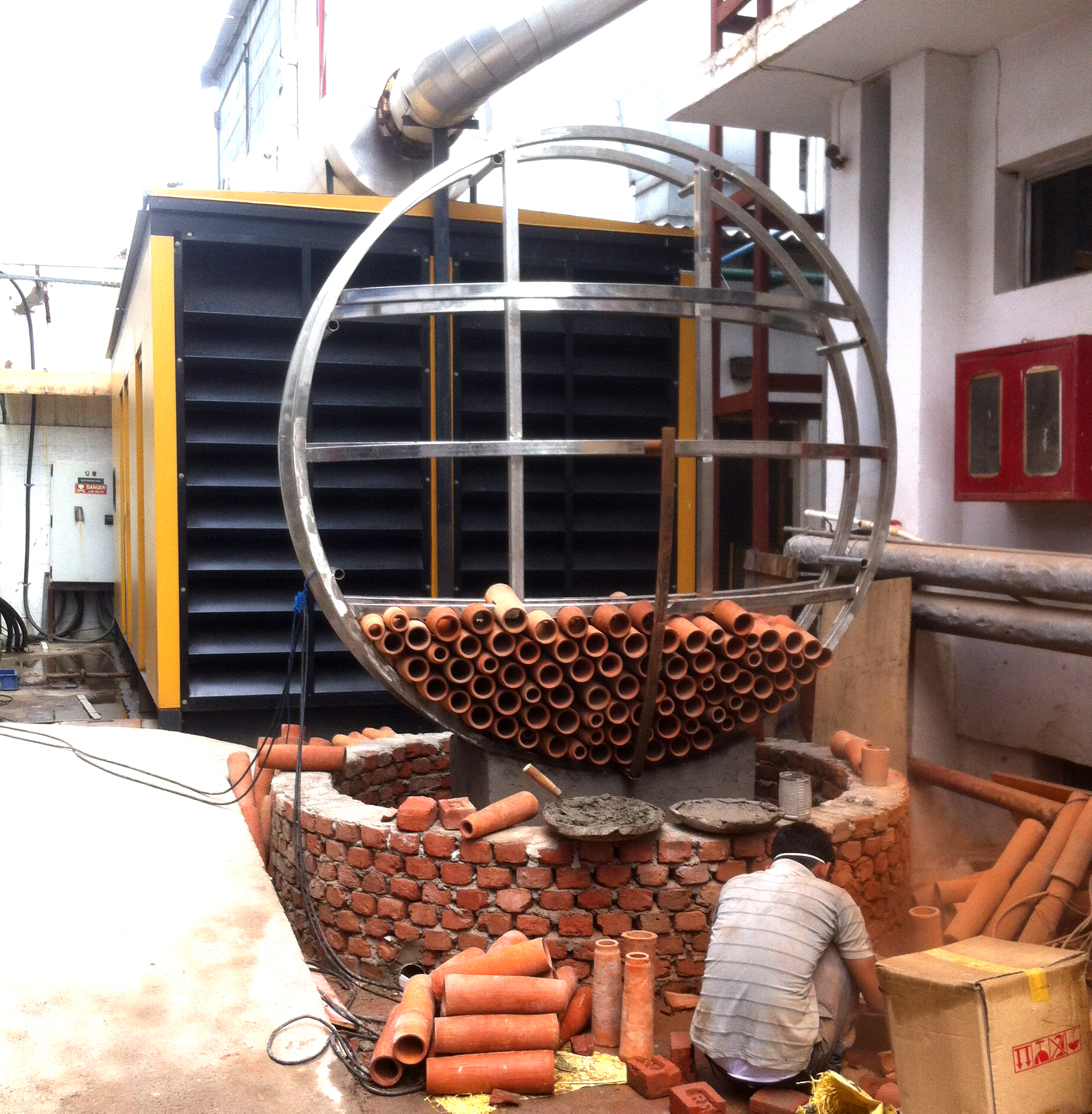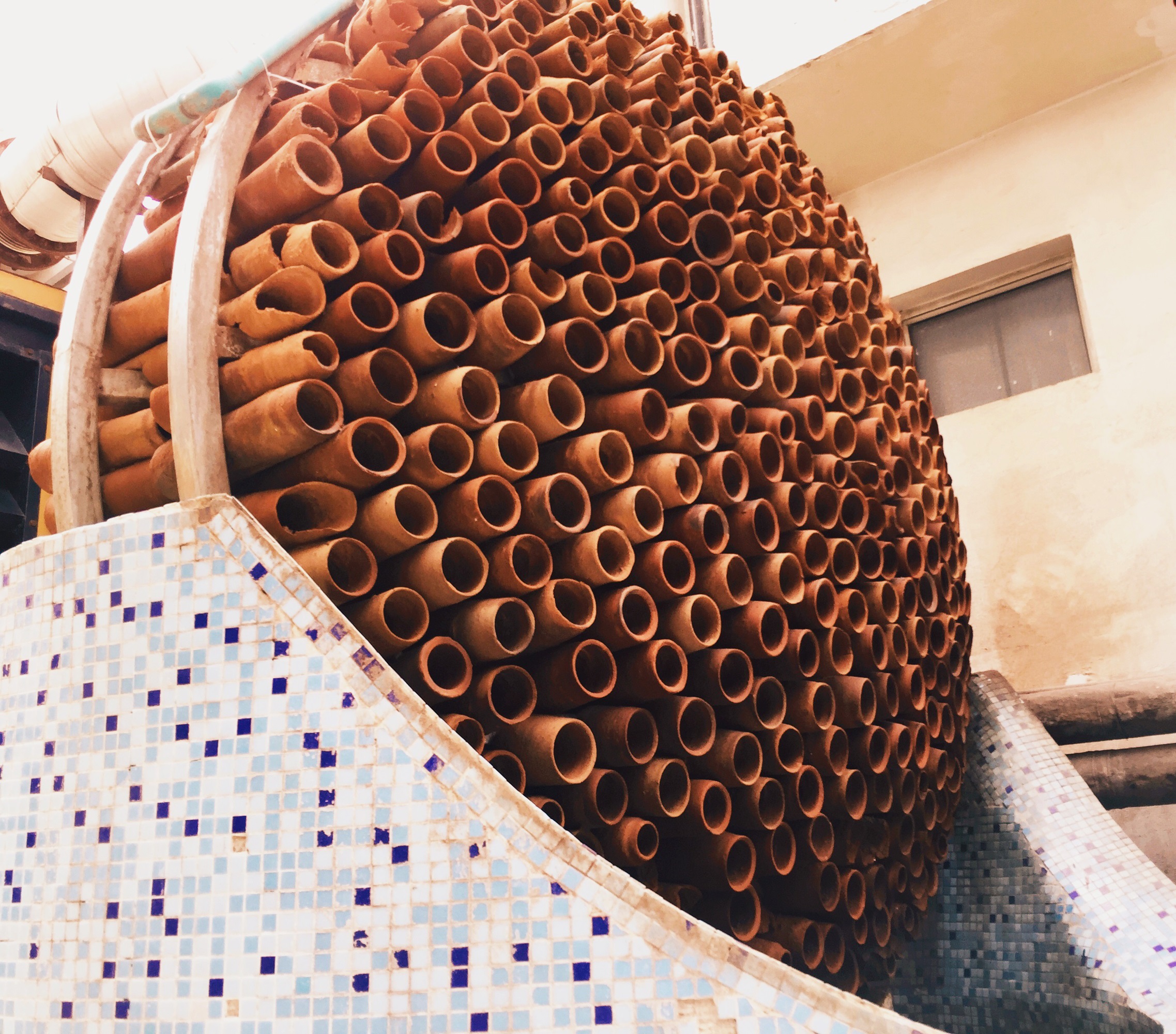








DESIGN AND INSTALLATION OF A COST-EFFECTIVE, ECO-FRIENDLY OUTDOOR COOLING SYSTEM
Status: Complete
Team comprises of : Monish Siripurapu, Abhishek Sonar, Atul Sekhar, Sudhanshu Kumar
CFD Analysis is done by SA Malik
Photograher for this project is S. Anirudh.

In India, heat waves are prevalent during summer season and stepping out in the sun would mean getting sun burnt in most parts of the country. The heat is so intense that it is normal to touch 40 degrees Celsius. This makes it difficult for people to survive the sweltering heat. If the heat from the sun is intolerable, imagine on the hottest month of the year getting baked from the heat radiating from the genset at the factory of Deki Electronics in Noida.
This is the ply of the workers working in the factories where an enormous amount of heat is released from the machine. Moreover, the genset was placed at the entrance of the factory, which is on the driveway causing a major exposure of heat to the workers. Everyone crossing this area on a regular day got affected by the continuous outflow of heat flow. The radiator of the DG set released copious amounts of hot air at high velocities towards the employees working/passing by in the driveway of the factory. Not only do sweltering employees lose enthusiasm and productivity, excessive heat can also take a toll on their health and wellbeing. Therefore, there was a dire need to come up with an economical solution to ease the burden of workers who find themselves in strenuous situations many times a day due to the excessive heat produced.

The design was inspired by the structure of a beehive. It used environment-friendly elements to construct an aesthetic piece of art, creating a technique that was functional and visually appealing at the same time. The conceived beehive structure was ready to be functional with the cones forming the desired pattern. The use of cylindrical cones provided for a larger surface area to maximize the cooling effect. The temperature of the air flow around the installation was recorded. It was noticed that the hot air entering the installation was above 50 degrees Celsius at a velocity of 10m/sec.
Water recycled from the factory at room temperature was allowed to run on the surface of the cylinders. This process cooled the hot air passing through the earthen pots. It was observed that after achieving the cooling effect, the temperature around the set up dropped down to 36 degrees Celsius while the temperature outside remained high at 42 degrees Celsius. And the air flow was recorded as 4m/sec. While recycled water might need regular maintenance to clean the pores on the exterior surface, regular water is recommended for long term performance.
The solution is ecological and artistic, and at the same time involves traditional craft methods. It allows for a low maintenance, sustainable and inexpensive alternative using porous terracotta and its inherent cooling properties, converting the hot air from the gen-set into a pleasant breeze.
Not only does this installation deliver the solution with utmost simplicity, but it is also a scalable and functional alternative, interpreted as an art installation.

The Egyptians fanned the porous jar of water to get cool air. The Romans on the similar concept, hung wet thick material on the doors of their houses or tents. Others, who were wealthy, constructed an artificial channel conveying water along the walls of their houses to reduce the temperature under extreme hot weather. These ideas from the past were analyzed and later assimilated in modern design form to create an energy efficient bee hive. Earthen cones, which is a sustainable resource to cool air was used. The team at Ant Studio used an old method to provide an effective solution. Evaporative Cooling is a technique that cools the surroundings by reducing the temperature using water and local materials. It is an ancient technique, tracing back to the Egyptian period. The eco-friendly cooling system worked on the ancient method of cooling, which is evaporative cooling. This process cools the air by reducing its temperature.

Ecological
The materials were chosen after careful study of their properties. Clay carries a negative charge and can bond with the positive pole of a water molecule - clay has Hygroscopic (water attracting) qualities. Clay is thus capable of absorbing water in a vapor phase as well as liquid. Moreover, clay contains no complex components or chemicals; it is completely recyclable and ultimately can be returned to earth.
Economical
The energy efficient device helped the factory to minimize the power consumption. Moreover, the use of locally available eco friendly materials and recycled water along with re-usable steel makes it a cost-efficient solution. This system requires minimal electricity (for the water pump). The water requirement is also minimal, since the water is circulated and pumped over and over again when the installation is in use. The water tank can be topped up monthly, or as per the capacity of the tank. No regular topping up is required.
Esthetic - From backyard to front yard
The idea is to break the regular norm of keeping the generators in the setback area of the place. The idea is to make them shift from the backyard to the front yard. In India, generator systems are usually placed in setback areas where loading and unloading takes place. We've pondered very intricately into the symmetrical geometry of the beehive and designed our product so that it can be interpreted as an art installation instead of just playing the functional role of an air conditioner.

The installation can also be converted into a zero-energy prototype which would require manual pouring of water over the pots once or twice a day. This can be done in areas where there is shortage of power supply, but it is not an ideal solution.
It is a scalable and functional module. It can be customized as an Art Installation as per certain requirements. There are many factories across the country that face similar issues with the DG set and require such indigenous and sustainable solutions. Therefore, the prototype could be used as a mass production element globally. Also, prospects to use the designed product in the interiors is being deliberated upon.

Pottery prospects have been dampened and sales are declining. Ant Studio has endeavored to revive the ancient art with the use of this concept in factories and other places, in a way it would generate employment for the potters.